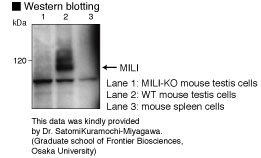Antibody detailed product information
| Code No. | PM044 | |
| Anti-PIWIL2 (MILI) (Mouse) pAb | ||
| Price | ¥52,800 | |
| Size | 100 µL | |
| Availability (in Japan) | 10 or more
(In Japan at 00:05, Apr 24, 2024 in JST) |
|
| Clonality | Polyclonal | |
| Clone | Polyclonal | |
| Isotype (Immunized Animal) |
Rabbit Ig (aff.) | |
| Applications | WB 1:1,000 IP 1 µL/sample IH* reported. (PMID: 29018194) RIP* reported. (PMID: 18381894 / 19735482 / 20439430) |
|
| Immunogen (Antigen) |
synthetic peptide VRKDREEPRSSLPDPS corresponding to Mouse PIWIL2 (107-122 a.a.) | |
| Reactivity [Gene ID] | Mouse[57746] |
|
| Storage buffer | PBS/50% glycerol, pH 7.2 | |
| Storage temp. | -20°C | |
| Conjugate | Unlabeled | |
| Manufacturer | MBL | |
| Background | The Piwi/Argonaute protein family plays important roles in stem-cell self-renewal, RNA silencing and translational regulation in various organisms. The family members are defined by conserved both PAZ (Piwi Argonaut and Zwille) and Piwi domains participate in RNA binding. Piwi-interacting RNA (piRNA) is a class of small RNA molecules that is expressed uniquely in mammalian testes and forms RNA-protein complexes with Piwi proteins. These small regulatory RNAs have been implicated in spermatogenesis, repression of retrotransposon transposition in germline cells, epigenetic regulation and positive regulation of translation and mRNA stability. MIWI (PIWIL1) and MILI (PIWIL2) are mouse homologues of Piwi. MILI is expressed from primordial germ cells (PGC) in embryo, whereas MIWI is detected later from the mid-pachytene stage to early round spermatids. Their expression overlaps in the mid-pachytene and early round spermatid stage. The expression patterns and knockout phenotypes of mammalian Piwi members indicated MILI is an essential factor for meiotic differentiation during spermatogenesis. | |
| Related products | RN003M Anti-EIF2C2 (AGO2) (Human) mAb RN1005 RIP-Assay Kit for microRNA D128-3 Anti-Phospho-STAT3 (Tyr708) mAb M207-3 Anti-MitoPLD (Pld6) mAb D289-3 Anti-Np95 (Uhrf1) (Mouse) mAb D356-3 Anti-Jmjd1c (Mouse) mAb M202-3 Anti-Np95 (Uhrf1) mAb RN125PW Anti-HENMT1 pAb D357-3 Anti-Ace (CD143) (Mouse) mAb D363-3 Anti-Ly6k (Mouse) mAb D365-3 Anti-PIWIL2 (MILI) (Mouse) mAb |
|
| Product category | Research area:Stem cell research RNA-RNP Network Epigenetics Cancer | |
| Data |  |
|
| Citations | Western Blotting
Immunoprecipitation
Immunohistochemistry
RNP Immunoprecipitation
|
|
- The availability is based on the information in Japan at 00:05, Apr 24, 2024 in JST.
- The special price is shown in red color.
- Please note that products cannot be ordered from this website. To purchase the items listed in this website, please contact us or local distributers.
- Abbreviations for applications:
WB: Western Blotting, IH: Immunohistochemistry, IC: Immunocytochemistry, IP: Immunoprecipitation
FCM: Flow Cytometry, NT: Neutralization, IF: Immunofluorescence, RIP: RNP Immunoprecipitation
ChIP: Chromatin Immunoprecipitation, CoIP: Co-Immunoprecipitation
DB: Dot Blotting, NB: Northern Blotting, RNA FISH: RNA Fluorescence in situ hybridization - For applications and reactivity:
*: The use is reported in a research article (Not tested by MBL). Please check the data sheet for detailed information.
**: The use is reported from the licenser (Under evaluation or not tested by MBL).
- For storage temparature: RT: room temparature
- Please note that products in this website might be changed or discontinued without notification in advance for quality improvement.
 Copyright (C)2015 Medical & Biological Laboratories Co., Ltd. All Rights Reserve
Copyright (C)2015 Medical & Biological Laboratories Co., Ltd. All Rights Reserve